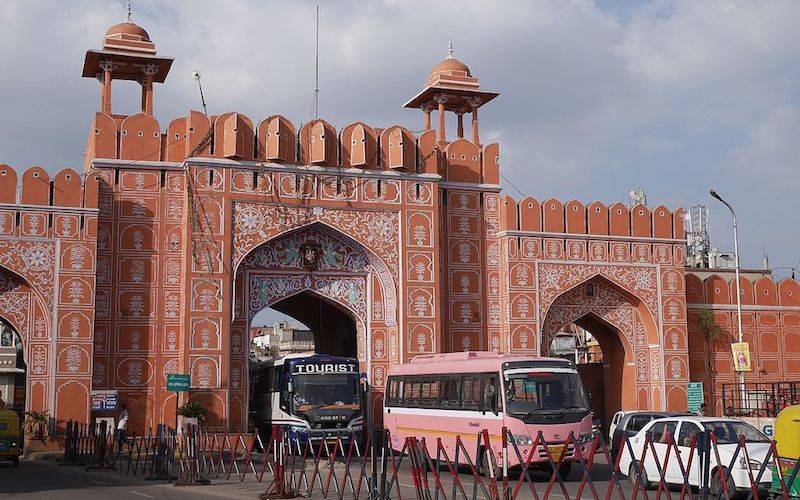Templeseeker is a participant in the Amazon Services LLC Associates Program and a Get Your Guide Partner. These are affiliate advertising programs designed to provide a means for us to earn fees by linking to Amazon.com and affiliated sites. Other affiliate links may be used in this article on places to visit in Jaipur, but they do not impact on the price that you pay and they do help me to get this information to you for free. Read my privacy policy for more information regarding affiliates.
Jaipur in Rajasthan is an Instagrammers paradise and often referred to as India’s ‘Pink City’. In 1876, the Prince of Wales and Queen Victoria visited India on a tour and Maharaja Ram Singh of Jaipur painted the whole city pink to welcome the guests (it’s the colour of hospitality). It is a city enshrined with fortresses, Hindu temples and markets. Jaipur forms part of the ‘Golden Triangle’ which many tourists visiting North India for a short amount of time like to follow – this consists of the route from Delhi – Agra – Jaipur. Here are the top places to visit in Jaipur.
Top Places to Visit in Jaipur
Amber Fort and Palace
About a half an hour drive straight from the city centre is one of the best places to visit in Jaipur – Amber Fort and Palace. Amber Fort sits over a hill overlooking Maota Lake. It was the home of Rajput rulers until Jaipur city was constructed, and contains a series of breath-taking palaces, halls, gardens, and temples. Inside, elaborate mirror work adds to the grandeur. The evening light and sound show, which brings the Fort’s history to life, is very impressive. The Anokhi Museum of Block Printing near the fort is another major attraction and workshops are held there regularly. Plan your trip to Amber Fort right away!
This Jaipur city tour includes Amber fort
Location: North of Jaipur. Regular buses depart from the Hawa Mahal to Amber Fort. Taxis are also available.
Entry Cost: 500 rupees for foreigners. 100 rupees for Indians. Night entry to the fort is 100 rupees per person.
Opening Hours: 8 a.m. to 5.30 p.m. during the day, and 7 p.m. to 10 p.m. at night. Please note that elephant rides are only achievable in the mornings until 11.30a.m.
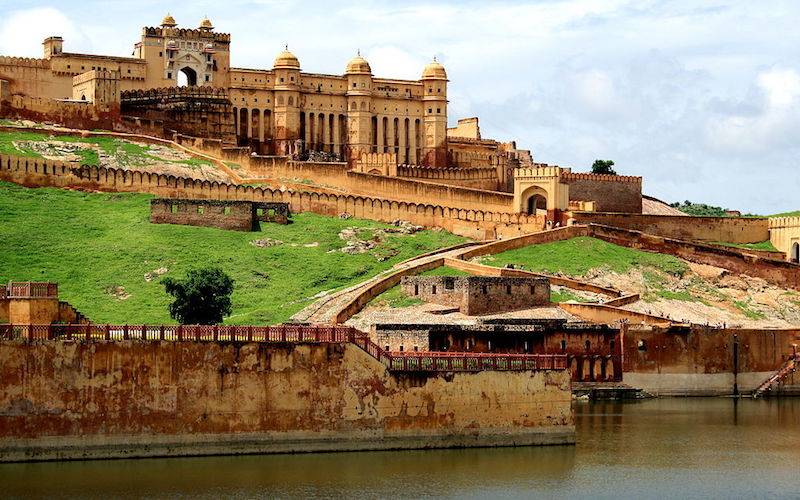
Jal Mahal – Water Palace
The Jal Mahal, informally known as the water palace is located near to the Amber fort and so it makes sense to see them on the same trip – most tours stop at both. The Jal Mahal is a low rise symmetrical palace that was built in 1799 by Maharaja Sawai Pratap Singh. You can only view it from the banks of the lake – tourists cannot go inside. It is only accessible by boat, and the romantic gondola boat rides that went up to the palace stopped a few years ago. 30 minutes is plenty of time to admire the architecture.
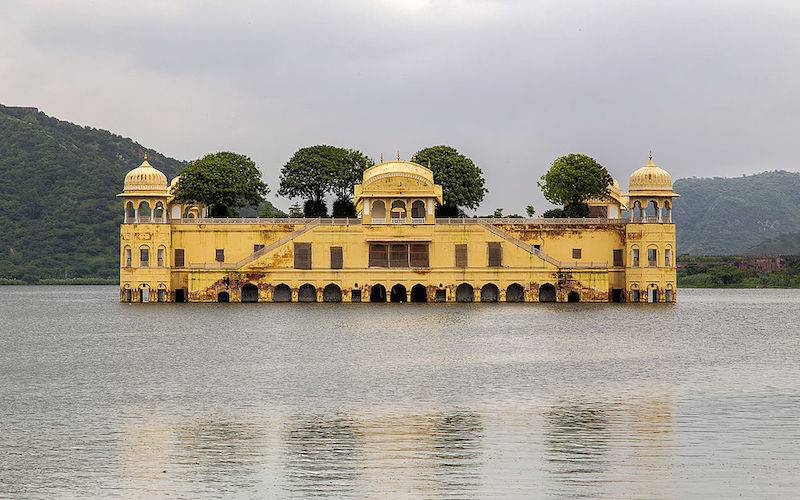
Location: Man Sagar Lake, near Amber Fort
Entry Cost: No entry allowed – admire from the river banks
Hours: Viewable all day as no entrance
Hawa Mahal Palace of the Winds
The fascinating and intricate facade of the Palace of the Winds is probably the most well-known of Places to Visit in Jaipur. Built in 1799, it has five floors that contain rows of small screens and windows. Wind once flowed through the openings, giving the palace its name. However, it has now gone from the Wind Palace as most of the windows have been sealed shut. Legend has it that this palace, which overlooks the main street of the lively Old City, was built so that the women of the household could watch the streets below without being observed. A panoramic view can be seen from the top of the building. This is one of my favourite monuments in Jaipur.
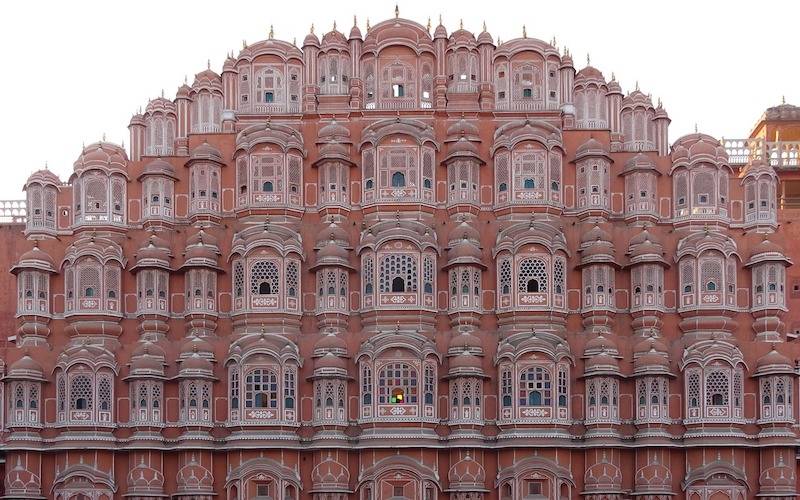
Location: Next to the City Palace. The entrance is from the back of the palace.
Entry Cost: 200 rupees for foreigners. 50 rupees for Indians.
Hours: 9 a.m. to 4.30 p.m. daily.
How long to spend in Jaipur? I’d recommend at least 3 days to fit in all of the major sights and explore the markets
City Palace
Upon visiting the glorious City Palace, it’s easy to see that the royal family of Jaipur was one of the wealthiest in India. The palace’s massive complex of gardens, courtyards and buildings blends both Rajasthani and Mughal architecture. The royal family still lives in the City Palace, in the elegant Chandra Mahal. It’s possible to access the private rooms, with a personal guide, for an additional cost. Additionally, inside the City Palace complex is an art gallery, museum and fascinating displays of royal costumes and old Indian weapons. A new exhibit dedicated to photography and paintings was added recently, including old photos of the woman of the palace. In addition, note that it’s now possible to visit the City Palace at night and see an outstanding sound and light show.
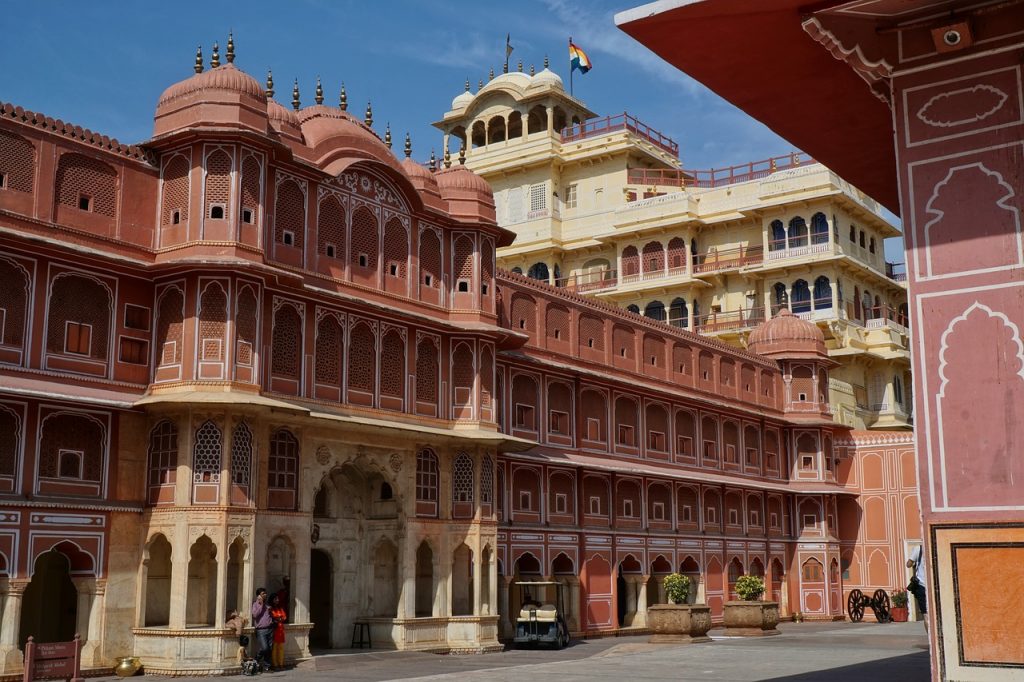
Location: Chokri Shahad, Old City, Jaipur.
Entry Cost: There are multiple ticket options for the City Palace, dependant on how much of it you want to see. Prices start from 200 rupees for Indians and 700 rupees for foreigners. Museum Night tickets cost 1,000 rupees for foreigners and 500 rupees for locals.
Hours: 9.30 a.m. to 5 p.m. daily. And 7 p.m. to 10 p.m. for night viewing.
Beware of Touts in Jaipur! I was approached by many people starting a conversation with ‘Can you help me with my English?’ and this would then progress to ‘I can take you to the Monkey Temple or Amber Fort! as a special treat!’ we heard from other tourists that they end up going on a very over-priced scam trip without an official tour guide.
Jantar Mantar Observatory
Built by King Jai Singh II between 1727 and 1734, Jantar Mantar means “calculation instrument”. More than just an inquisitive collection of sculptures, each structure at the fascinating Jantar Mantar observatory has a specialized astronomical function. There is a total of 14 structures, which measure time, track stars and predict eclipses. The most impressive one is the massive Samrat Yantra sundial. At a height of 90 feet, it has a shadow that moves around the width of a person’s hand each minute. It’s a philosophical display of how quickly time goes and was surprisingly fascinating for me!
Location: Found next to the City Palace, Jaipur.
Entry Cost: 200 rupees for foreigners. 50 rupees for locals.
Hours: 9 a.m. to 4.30 p.m. daily.
Jaigarh Fort
Built in 1726, Jaigarh Fort holds great appeal for military fans. Bordered by gateways and watchtowers, it possesses the world’s largest cannon on wheels. The cannon has never been fired though, and neither has the fort been captured. As a result, the fort has remained intact over its long life, and is very well preserved. All in all, it’s one of the best-preserved military structures of medieval India. Jaigarh doesn’t possess the delicate interiors of Amber Fort, and therefore acts as a real fortress. Ascend the Diwa Burj watchtower to get an amazing view over the plains.
Location: Behind Amber Fort, North of Jaipur, (within walking distance).
Entry Cost: 35 rupees for Indians and 85 rupees for foreigners.
Opening hours: 9am – 4.30pm every day.
Nahargarh Fort
Nahargarh Fort, more commonly known as Tiger Fort, is suspended high on the rugged Aravali Hills overseeing Jaipur city. The fort was built 1734 to defend the city. It found fame in 2006, after many scenes from the movie Rang De Basanti were filmed there. The fort provides spectacular views, that are best seen at sunset. A large number of new attractions opened recently including a sculpture park, wax museum and fine-dining restaurant. There is also a cafe on the grounds, which serves snacks and alcohol until 10pm. The fort looks mainly eye-catching at night when it is lit up.
Location: North west of Jaipur city centre. Get there by taxi, local bus or a steep half hour walk directly up the hill.
Entry Cost: 200 rupees for foreigners. 50 rupees for Indians.
Opening hours: Sunrise to sunset, daily. Palace open from 10 a.m. to 5.30 p.m. daily.
Markets and Shopping
Jaipur is a lovely place to shop and you’ll find an alluring variety of goods accessible there. Some of the most popular items are precious gemstones, silver jewellery, bangles, clothes, blue pottery, and textiles. For a splash of fragrant colour, don’t miss stopping by the wholesale flower market (phool mandi) just inside Chandi ki Taksal gate in the Old City. It’s on from 6 a.m. Head there on Saturday mornings to catch the adjacent Hatwara flea market, which is delightfully free of tourists.
Location: The focal shopping area is on M I Road. Johari Bazaar, in the Old City, is renowned for bangles, inexpensive costume jewellery, gold and silver. Maniharon ka Rasta is an entire lane full of lac bangle makers.
Hours: Multiple shops are closed only on Sundays.
Hide your money in a belt or inside zip pocket – unfortunately Jaipur is a place that is abundant with pick-pockets
Government Central (Albert Hall) Museum
This old and famous museum was modelled on the Victoria and Albert Museum in London, with a fusion of Islamic and Neo-Gothic architecture. It was established as a public museum in 1887. The collection includes portraits of local kings, costumes, woodcarvings, paintings, and arts and crafts. The museum is quite notable for its Egyptian mummy, belonging to the Ptolemaic dynasty. Unfortunately, photography isn’t allowed. The museum is beautifully illuminated after dark and it opened for night viewing in 2015.
Location: Ram Nivas Bagh, south of the Old City, Jaipur.
Entry Cost: 300 rupees for foreigners. 40 rupees for Indians. Museum Night tickets cost 100 rupees for foreigners and locals.
Hours: 10 a.m. to 5 p.m. daily. And 7 p.m. to 10 p.m. for night viewing.
Monkey Temple
Getting to this rather ruinous but holy Hindi temple, nestled in peaceful surroundings between two granite cliffs, is quite an adventure but it’s completely worth the effort. The monkey temple is part of a larger temple complex, which has three holy pools of water. One of the pools has been made home by thousands of monkeys that congregate there to bathe and swim. They’re normally friendly and like to be fed. Unfortunately, the area is not well maintained. Be prepared to encounter dirty and trash, as well as priests and pseudo holy men coercing people for money. These days, most of the crowd consists of tourists rather than locals.
Location: Outside Galta Pol, at the far eastern side of the city near Agra Road. To get to the temple, take a rickshaw, hike up the hill to the white Sun Temple and then follow the steps downhill into the gorge.
Entry Cost: Free
Hours: Ideal time to visit is late afternoon around sunset, when the monkeys flock to the temple.
Museum of Legacies
This new government museum is dedicated to promoting the cultural heritage of Rajasthan. It’s retained in an atmospheric heritage building dating all the way back to 1825, which once operated as the Rajasthan School of Arts. There’s around 10,000 square feet of exhibition space containing previously hidden private collections of jewellery, textiles, stoneware and inlay work, pottery, paintings and photography.
Location: Kishanpole Bazaar, Modikhana, Jaipur.
Hours: Noon to 8 p.m., daily except Mondays (closed).
Elefantastic
Elefantastic provides an ethical opportunity to get up close with some of India’s much-admired elephants for the day. An elephant sanctuary in a care village, Elefantastic was made in 2012 to encourage the wellbeing of the wonderful creatures and show tourists that not all of them are mistreated in India. At the sanctuary, you’ll be able to feed, wash and water the elephants along with learning more about them in a decorating/painting class and about the elephants’ medicines and treatments. Many elephant parks similar to this have opened in the area but Elefantastic is the most trustworthy and popular one. Of course, there are ethical questions surrounding Elephant tourism – do your research, ask questions about the animals welfare and avoid riding Elephants.
Location: Delhi Road, 90 Chandra Mahal Colony, Jaipur (near Amber Fort).
Cost: Foreigners can expect to pay 4,000-5,100 rupees per adult (discounts available for children), depending on the time of year. The price for Indian adults is 2,000-3,500 rupees. This includes all activities and a vegetarian meal.
Amrapali Museum
Another brand-new museum in Jaipur, this one is India’s first museum especially for jewellery and jewelled objects. As its name suggests, it was founded by Amrapali, a renowned Indian luxury jewellery house favoured by Bollywood stars. All the exhibits in this remarkable museum are from the personal collection of the brand’s owners, which they’ve amassed over 40 years, from the time they started sourcing jewellery and opened their business. There are some very unusual items such as silver anklets for horses, a Parsi necklace with a hidden message, a holy water flask, bejewelled tooth cleaners, and ruby-studded back scratcher with conceal blades.
Location: Panch Batti, K-14/B Ashok Road, C Scheme, Ashok Nagar, Jaipur.
Hours: 9 a.m. to 6 p.m. on weekdays.
Bagru Village
If you’re interested in textiles and traditional block printing, don’t miss taking Studio Bagru’s half-day group tour to Bagru village, located about an hour southwest of Jaipur. The entire village is devoted to the craft of block printing and you’ll be able to see the artisans there and observe them in action. You’ll also get to see the fabric drying in the sun. Full day workshops, and print off your own scarf workshops are also possible in Bagru Village.
Location: 3 Vinoba Marg, C-Scheme, Jaipur.
Hours: The tour runs in the morning.
Places to Visit in Jaipur – Restaurants
Stepout Cafe & Book Lounge
Stepout Cafe is a cafe with an exclusive travel theme and with world cuisine and a book lounge and with healthy breakfast to try. Best seller books have been availed here. Book donation is offered so that other people can also enjoy once you are done reading, and you get offered a complimentary cappuccino too. The outlet provides three separate areas and suitable for a private get together, meetings etc. Cuisine includes Italian, Mexican, Lebanese, Indian snacks.
Mosaic
The Radisson Jaipur City Center provides 24-hour on-site dining at Mosaic. You may choose a locally inspired or international dish from an à la carte menu or enjoy the restaurant’s buffet. Your stay in Jaipur also has access to the Confectionary Shop, situated on the same level as Mosaic, where you may fulfil your sweet cravings with a freshly baked tasty treat.
Hi-LiFE the Rooftop Grill
Hi-LiFE the Rooftop Grill has global cuisine which specialises in fusion food with an array of exquisite Italian, Chinese, Mexican, Japanese and Indian selection. The restaurant is based on a concept of Great food, Pure delight and exotic drinks which are pleasurable in an open-air, relaxing poolside ambiance with the classic collection of euphonic and soft western music.
Places to Visit in Jaipur – Where to Stay
Shahpura House
Shahpura house consists of 38 guest rooms are beautifully decorated and include 24-hour room service, air conditioning, and Internet access. The Shedhawati Frescos rooftop offer the best local Rajasthani and international cuisine.
Radisson Blu Jaipur
The Radisson Blu Jaipur is a 5 star hotel just 5 minutes away from the World Trade Park and 12km from the centre of Jaipur. Refresh in one of the 182 stylish suites and rooms, all bundled with all necessary amenities including four fixture bathroom and free high-speed wireless Internet.
Golden Tulip Hotel Jaipur
Allowing easy access to the Jaipur International Airport, the Golden Tulip Hotel Jaipur provides an unrivalled accommodation for a visit in the “pink city” of Jaipur. The property provides tastefully decorated designer rooms that are cosy, yet modern. Perfect for someone flying in for a long weekend.
What to pack for India
Consider packing conservative clothing and a shawl or headscarf for women if you would like to visit religious places. Some comfortable sandals work well in India as it can be hot so they will let your feet breathe. It can get extremely hot in some parts of India and so sun cream is essential.

It’s a good idea to pack conservative clothing for India. Avoid short skirts and low cut tops or spaghetti straps. Comfortable trousers and linen tops are great. Long skirts and Maxi dresses also work really well and are comfortable with the heat. Comfortable loose cotton or linen trousers are perfect. Don’t forget your sunglasses, and pack your prescription sunnies if you have those!

Further Reading on India
If you are lucky enough to have more time and looking for a suitable add on to your Jaipur trip, I recommend Pushkar. Located on one of the holiest lakes in India, this holy city is home to one of the few Brahma temples in India.

